Methodology for Prioritizing Value-Added Options for Agricultural Products: Insights from Coconut-Producing Communities in Cauca, Colombia
Abstract
:1. Introduction
1.1. Theoretical Foundation
1.1.1. Added Value, Technological Innovation, and Social Innovation
1.1.2. Methodologies and Tools for Innovation
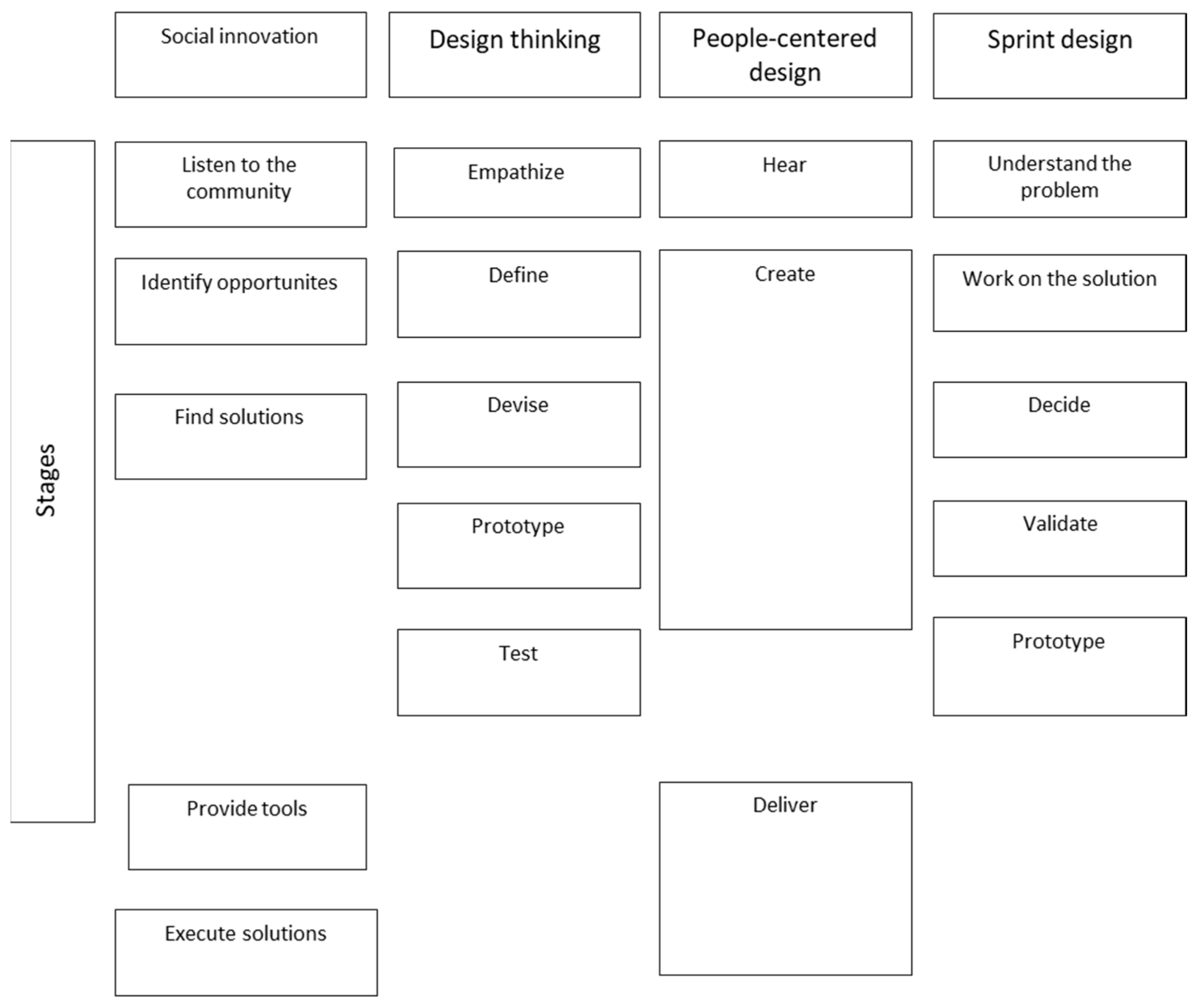
2. Materials and Methods
2.1. Roles Defined in the Methodology
2.2. Sprint 1. In Search of Desirable Solutions
2.3. Sprint 2. In Search of Feasible Products
2.4. Sprint 3. In Search of Viable Solutions
3. Results
4. Discussion
5. Conclusions
Author Contributions
Funding
Institutional Review Board Statement
Informed Consent Statement
Data Availability Statement
Acknowledgments
Conflicts of Interest
References
- Banco Mundial. Panoramas Alimentarios Futuros. Reimaginando la Agricultura en América Latina y el Caribe. 2021. Available online: https://www.bancomundial.org/es/region/lac/brief/future-foodscapes-re-imagining-agriculture-in-latin-america-and-the-caribbean (accessed on 30 June 2021).
- Rodríguez, A.; Rodrigues, M.; Sotomayor, O.; Wonder, P. Innovación, Agregación de Valor y Diferenciación: Estrategias Para el Sector Agroalimentario de América Latina y el Caribe en un Mundo Complejo. 2030—Alimentación, Agricultura y Desarrollo Rural en América Latina y el Caribe, 13; FAO: Santiago, Chile, 2019. [Google Scholar]
- Comisión Económica para América Latina y el Caribe—CEPAL—2019. Panorama Social de América Latina. Available online: https://repositorio.cepal.org/bitstream/handle/11362/44969/5/S1901133_es.pdf (accessed on 15 September 2020).
- Comisión Económica para América Latina y el Caribe—CEPAL—2021. Objetivos de Desarrollo Sostenible. Available online: https://www.un.org/sustainabledevelopment/es/objetivos-de-desarrollo-sostenible/ (accessed on 24 July 2023).
- Departamento Administrativo de Ciencia, Tecnología e Innovación—Colciencias—Ministerio de Agricultura y Desarrollo Rural y Corporación Agropecuaria de Investigación Agropecuaria—Corpoica. Plan Estratégico de Ciencia, Tecnología e Innovación del Sector Agropecuario Colombiano PECTIA (2017–2027). 2016. Available online: https://minciencias.gov.co/sites/default/files/upload/noticias/pectia-2017-actualizado.pdf (accessed on 4 May 2021).
- Allied Market Research. Coconut Products Market. Global Opportunity. Analysis and Industry Forecast, 2019–2026. 2019. Available online: https://www.alliedmarketresearch.com/coconut-products-market (accessed on 30 June 2019).
- Organización de las Naciones Unidas para la Agricultura y la Alimentación—FAO. Sector del Coco: Análisis de Mercado y Aspectos Socioeconómicos Marco General Sobre el Sector del Coco en Jamaica, Ghana y México. 2020. Available online: https://www.tropicsafe.eu/wp-content/uploads/2022/02/Sector-del-coco-an%C3%A1lisis-del-mercado.pdf (accessed on 10 November 2021).
- Red de Información y Comunicación del Sector Agropecuario Colombiano—AGRONET. Data from: Producción de coco por Departamentos en Colombia. 2021. Available online: https://www.agronet.gov.co/ (accessed on 28 March 2022).
- Caracterización de Productores de coco de los Municipios Guapi, Timbiquí y López de Micay; Unpublished document from Proyect “Fortalecimiento de la Cadena productiva del coco de la costa pacífica Caucana”; University of Cauca: Cauca, Colombia, 2022.
- Organización de las Naciones Unidas para la Agricultura y la Alimentación—FAO—2017. Sistemas de Innovación Para el Desarrollo Rural Sostenible. Available online: https://www.fao.org/3/i7769s/i7769s.pdf (accessed on 8 October 2019).
- Choriboga, M. (s.f.). Innovación, Conocimiento y Desarrollo Rural. Available online: https://www.rimisp.org/wp-content/files_mf/13591380833.pdf (accessed on 17 September 2021).
- Stevens, G.; Burley, J. 3000 Raw Ideas Equals 1 Commercial Success! J. Res. Technol. 1997, 40, 16–28. Available online: https://basesbiblioteca.uexternado.edu.co:2199/10.1080/08956308.1997.11671126 (accessed on 6 July 2021).
- Frey, C.; How to Prioritize, Filter and Plan Ideas. Innovation Managment. 2009. Available online: https://innovationmanagement.se/2009/02/05/innovation-management-how-to-prioritize-filter-and-plan-ideas/ (accessed on 5 February 2019).
- Comisión Económica para América Latina y el Caribe—CEPAL—2022. Soluciones Basadas en la Naturaleza y la Bioeconomía: Contribución a una Transformación Sostenible. Available online: https://issuu.com/publicacionescepal/docs/s2200230_es (accessed on 24 July 2023).
- Gobierno de Colombia. Bioeconomía: Para una Colombia Potencia Viva y Diversa. Hacia una Sociedad Impulsada por el Conocimiento. 2020. Available online: https://minciencias.gov.co/sites/default/files/upload/paginas/bioeconomia_para_un_crecimiento_sostenible-qm_print.pdf (accessed on 5 May 2021).
- Riveros, H.; Heinrich, W. Valor Agregado en los Productos de Origen Agropecuario: Aspectos Conceptuales y Operativos. San José, Costa Rica. Imprenta IICA. 2014. Available online: http://repiica.iica.int/docs/B3327e/B3327e.pdf (accessed on 15 February 2022).
- Balderrama, J. Modelos de Desarrollo de Innovación y de Relación Universidad-Empresa-Estado. Revista Acta Nova 2003, 2, 423–431. Available online: http://www.scielo.org.bo/scielo.php?script=sci_arttextandpid=S1683-07892003000200010 (accessed on 27 June 2021).
- Organización para la Cooperación y el Desarrollo Económico (OECD). Manual de Frascati, 1993: Propuesta de Norma Práctica para Encuestas de Investigación y Desarrollo Experimental; Organización para la Cooperación y el Desarrollo Económico: Paris, France, 1993. [Google Scholar]
- Benavides, O. La innovación tecnológica desde una perspectiva evolutiva. Cuad. Econ. 2004, 23, 49–70. [Google Scholar]
- Chesbrough, H. Open Business Models: How to Thrive in a New Innovation Landscape; Harvard Business School Press: Boston, MA, USA, 2006. [Google Scholar]
- Rodríguez-Ferradas, M.I.; Alfaro-Tanco, J.A. Open innovation in automotive SMEs suppliers: An opportunity for new product development. Universia Bus. Rev. 2016, 50, 142–157. [Google Scholar]
- Hubert, A. Empowering People, Driving Change: Social Innovation in the European Union. 2010. Available online: http://www.net4society.eu/_media/Social_innovation_europe.pdf (accessed on 25 February 2019).
- Arenilla, M.; García, R. Innovación Social. La Integración Social en la Administración Pública; Editorial Netbiblo: La Coruña, Spain, 2013. [Google Scholar]
- Mootee, I. Design Thinking para la Innovación Estratégica: Lo que no te Pueden Enseñar en las Escuelas de Negocios ni en las de Diseño; Ediciones Urano: Barcelona, Spain, 2013. [Google Scholar]
- Herrera, M. Innovación para el Crecimiento Social y Empresarial. People & Business Advantage. 2016. Available online: https://pbacr.com/blog/innovacion-social.html (accessed on 16 June 2021).
- Hicks, P. Fundamentos de la Ingeniería Industrial. In Manual del Ingeniero Industrial; Maynard, E.H., Ed.; McGraw Hill: México City, México, 2005. [Google Scholar]
- Córdoba, A.; Arteaga, J.; Bonilla, H. Fundamentos del pensamiento de Diseño. Investigium IRE Cienc. Soc. Hum. 2015, 7, 38–50. [Google Scholar] [CrossRef]
- IDEO. Diseño Centrado en las Personas. Kit de Herramientas. 2011. Available online: https://hcd-connect-production.s3.amazonaws.com/toolkit/en/spanish_download/ideo_hcd_toolkit_final_combined_lr.pdf (accessed on 5 May 2021).
- Angulo Sillas, M. Diseñando Experiencias con Design Sprint. Revista Digital Universitaria. Universidad Nacional Autónoma de México. 2016. Available online: http://www.revista.unam.mx/vol.17/num6/art45/ (accessed on 21 September 2021).
- Enríquez, J.G.; Morales Trujillo, M.; Olivero, F.J.; Domínguez Mayo, I.; Ramos Mejía, M. Hacia una metodología para el desarrollo guiado y sistemático de los trabajos fin de grado. Actas Jenui 2018, 3, 205–212. [Google Scholar]
- Ries, E. El Método Lean Startup; Deusto: Barcelona, Spain, 2012; ISBN 9789584260925. [Google Scholar]
- Llamas Fernández, F.J.; Fernández Rodríguez, J.C. La Metodología Lean Startup: Desarrollo y Aplicación para el Emprendimiento. Rev. Esc. Adm. Neg. 2018, 84, 79–95. [Google Scholar] [CrossRef]
- Rantanen, K.; Conley, D.W.; Domb, E.R. Simplified TRIZ: New Problem-Solving Applications for Technical and Business Professionals, 3rd ed.; CRC Press: Boca Raton, FL, USA, 2002. [Google Scholar]
- Cortés Robles, G.; García Alcaraz, J.L. Hernández, G.A. Managing Innovation in Highly Re-strictive Environments; Spinger: Cham, Switzerland, 2019. [Google Scholar]
- Trigas, M. Metodología Scrum. Bachelor’s Thesis, Universitat Oberta de Catalunya, Catalunya, Spain, 2014. Available online: http://hdl.handle.net/10609/17885 (accessed on 26 May 2021).
- Vidal-Artal, J.; Miralbés-Buil, R. Adaptation of the Scrum Methodology to Management of University Innovation Projects in Industry 4.0. DYNA Manag. 2022, 10, 12. [Google Scholar] [CrossRef]
- Chan, W.; Mauborgne, R. La Estrategia del Océano Azul: Cómo Desarrollar un Nuevo Mercado Donde la Competencia no Tiene Ninguna Importancia; Grupo Editorial Norma: Bogotá, Colombia, 2005. [Google Scholar]
- Chirinos, C. Nicho de mercado: El enfoque desde el océano azul. Ing. Ind. 2011, 29, 171–181. Available online: https://revistas.ulima.edu.pe/index.php/Ingenieria_industrial/article/view/233/209 (accessed on 17 September 2021). [CrossRef]
- Osterwalder, A.; Pigneur, Y.; Bernarda, G.; Smith, A. Diseño de Propuesta de Valor; Deusto: Barcelona, Spain, 2014. [Google Scholar]
- Osterwalder, A. The Business Model Ontology. A Proposition in a Design Science Approach. Ph.D. Thesis, University of Laussane, Laussane, Switzerland, 2004. [Google Scholar]
- Osburg, T.; Schmidpeter, R. Social Innovation. Solutones for a Sustainable Future; Springer: Berlin/Heidelberg, Germany, 2013. [Google Scholar]
- Organización de las Naciones Unidas para la Agricultura y la Alimentación—FAO—2023. Servicios Ecosistémicos y Biodiversidad. Available online: https://www.fao.org/ecosystem-services-biodiversity/es/ (accessed on 24 July 2023).
- Molina Azorín, J.F.; López Gamero, M.D.; Pereira Moliner, J.; Pertusa Ortega, E.M.; Tarí Guilló, J.J. Métodos híbridos de investigación y dirección de empresas: Ventajas e implicaciones. Cuad. Econ. Dir. Empresa 2012, 15, 55–62. [Google Scholar] [CrossRef]
- Lugo Perea, L.J.; Rodriguez Rodriguez, L.H. El agroecosistema: ¿objeto de estudio de la agroecología o de la agronomía ecologizada? Anotaciones para una tensión epistémica. Interdisciplina 2018, 6, 89–112. [Google Scholar] [CrossRef]
- Avendaño-Leadem, D.F.; Cedeño-Montoya, B.C.; Arroyo-Zeledón, M.S. Integrando el concepto de servicios ecosistémicos en el ordenamiento territorial. Rev. Geográfica América Cent. 2020, 2, 63–78. [Google Scholar] [CrossRef]
- Soriano, M.D.; García, F.; García-España, L. Residuos de coco. Arte y vermicompostado para su reutilización. In Proceedings of the Actas del III Congreso Internacional sobre Patrimonio Alimentario y Museos, Valencia, España, 25–26 November 2021; pp. 281–290. [Google Scholar] [CrossRef]
- Ruiz, J.; Lozano, D.; González, J. Propiedades físicas y mecánicas de la madera plástica para uso en estructura de atención y prevención de desastres de la “ESMIC”. Ingeniare 2019, 27, 31–39. [Google Scholar] [CrossRef]
- García García, R.M.; López Fernández, J.F.; Muzha Chávez, M.A.; Villafuerte Rodríguez, M.A. Proceso de obtención de fibra de coco para fabricar colchones ecológicos hipoalergénicos en la comuna “Sacachún”. Rev. Empres. 2017, 11, 14–19. [Google Scholar]
- Organización Internacional del Trabajo—OIT. Transición Justa Hacia una Economía Rural, Resiliente y Sostenible. Trabajo decente en la Economía Rural. 2019. Available online: https://www.ilo.org/wcmsp5/groups/public/---ed_dialogue/---sector/documents/publication/wcms_437224.pdf (accessed on 11 December 2021).
- Finquelievich, S.; Fischnaller, C. Ciencia ciudadana en la Sociedad de la Información: Nuevas tendencias a nivel mundial. Rev. Iberoam. Cienc. Tecnol. Soc. CTS 2014, 9, 11–31. [Google Scholar]
- Blasco Ejarque, J.L.; Tirado, F.; Martorell, J.R. Ciencia ciudadana y nuevas relaciones de poder y control. Nómadas 2021, 55, 95–109. [Google Scholar] [CrossRef]
- Escobar Lago, M. Emprendimiento Social, Lean Startup y Trabajo Social. Serv. Soc. Política Soc. 2018, 35, 102–112. [Google Scholar]
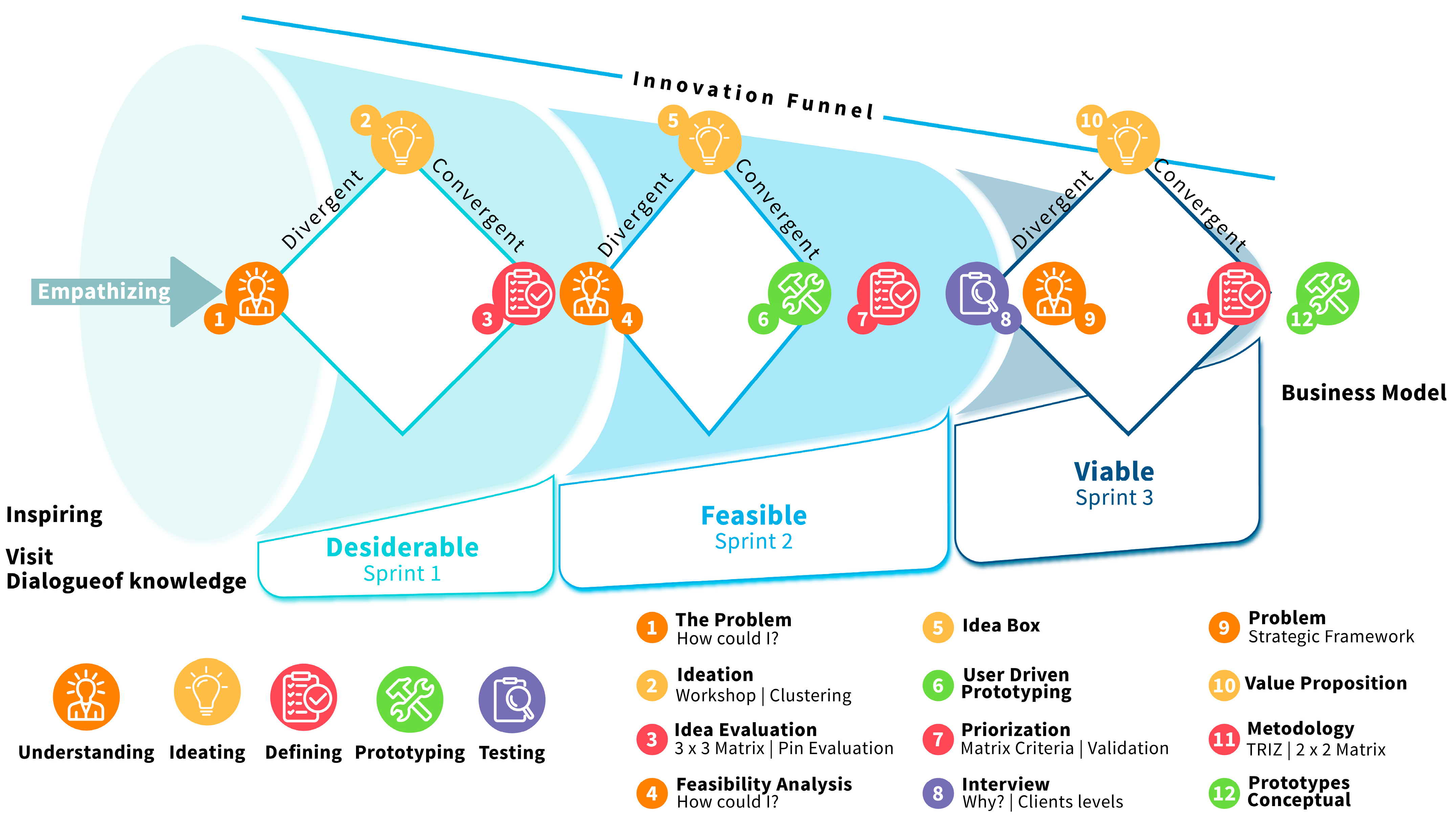
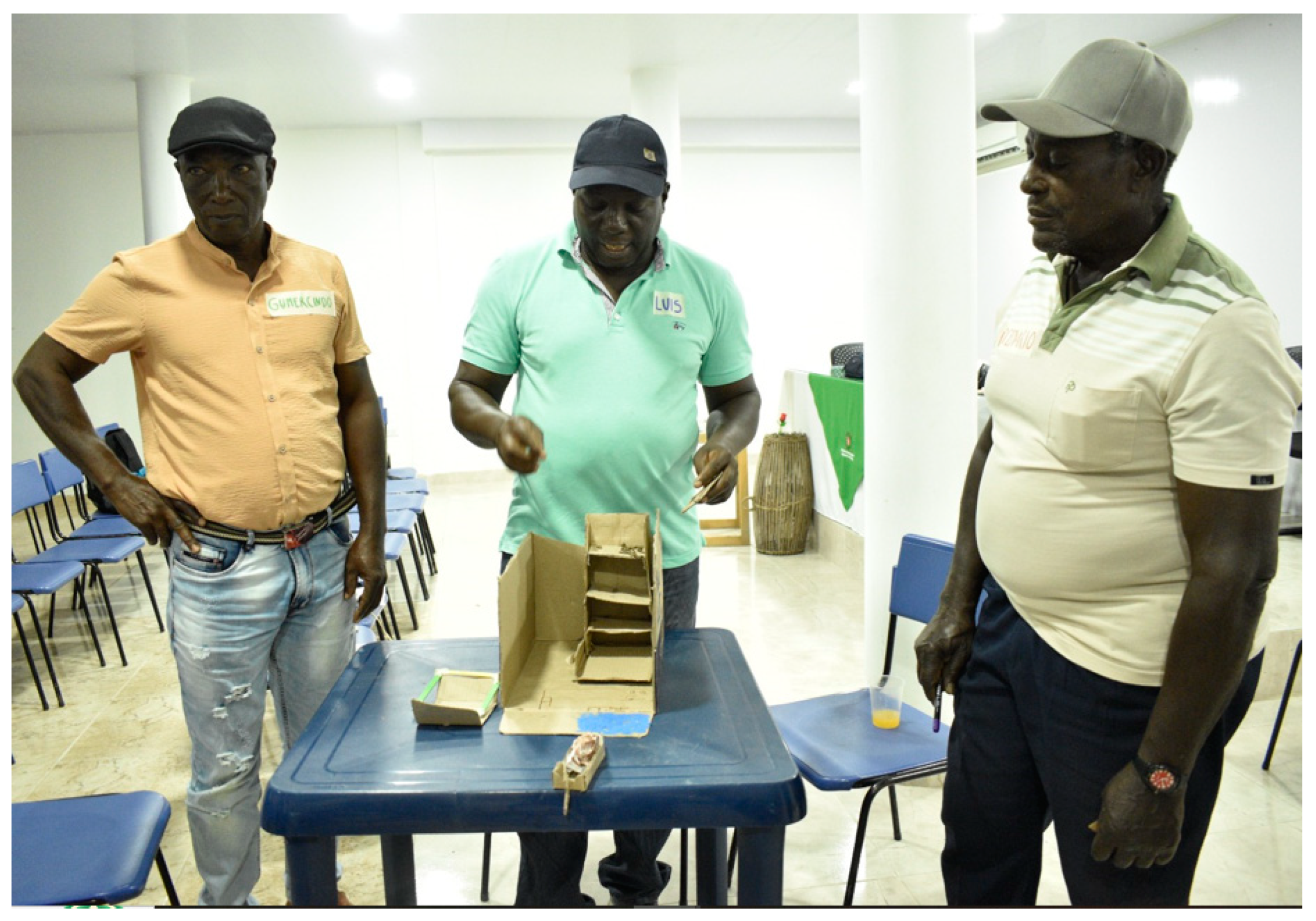
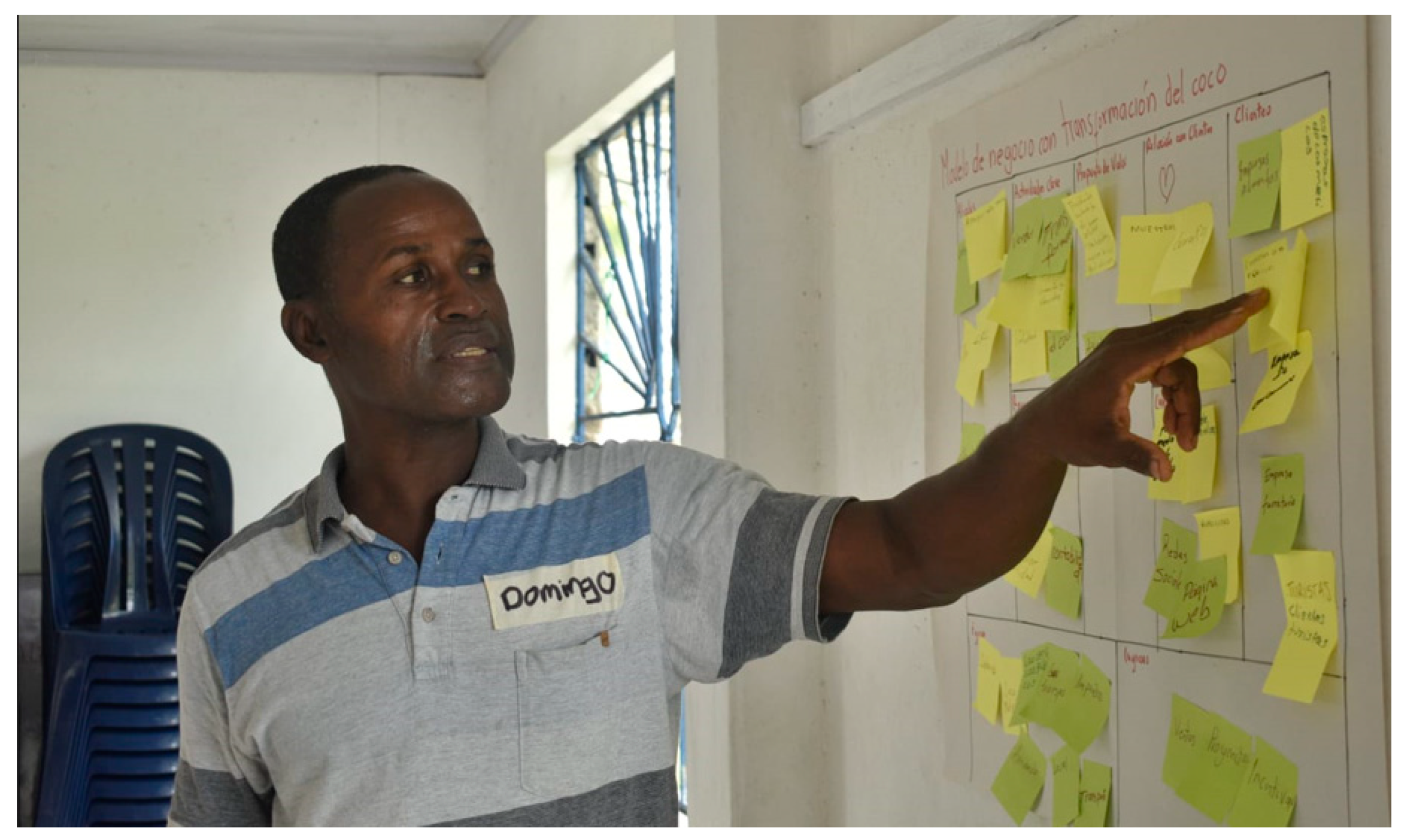
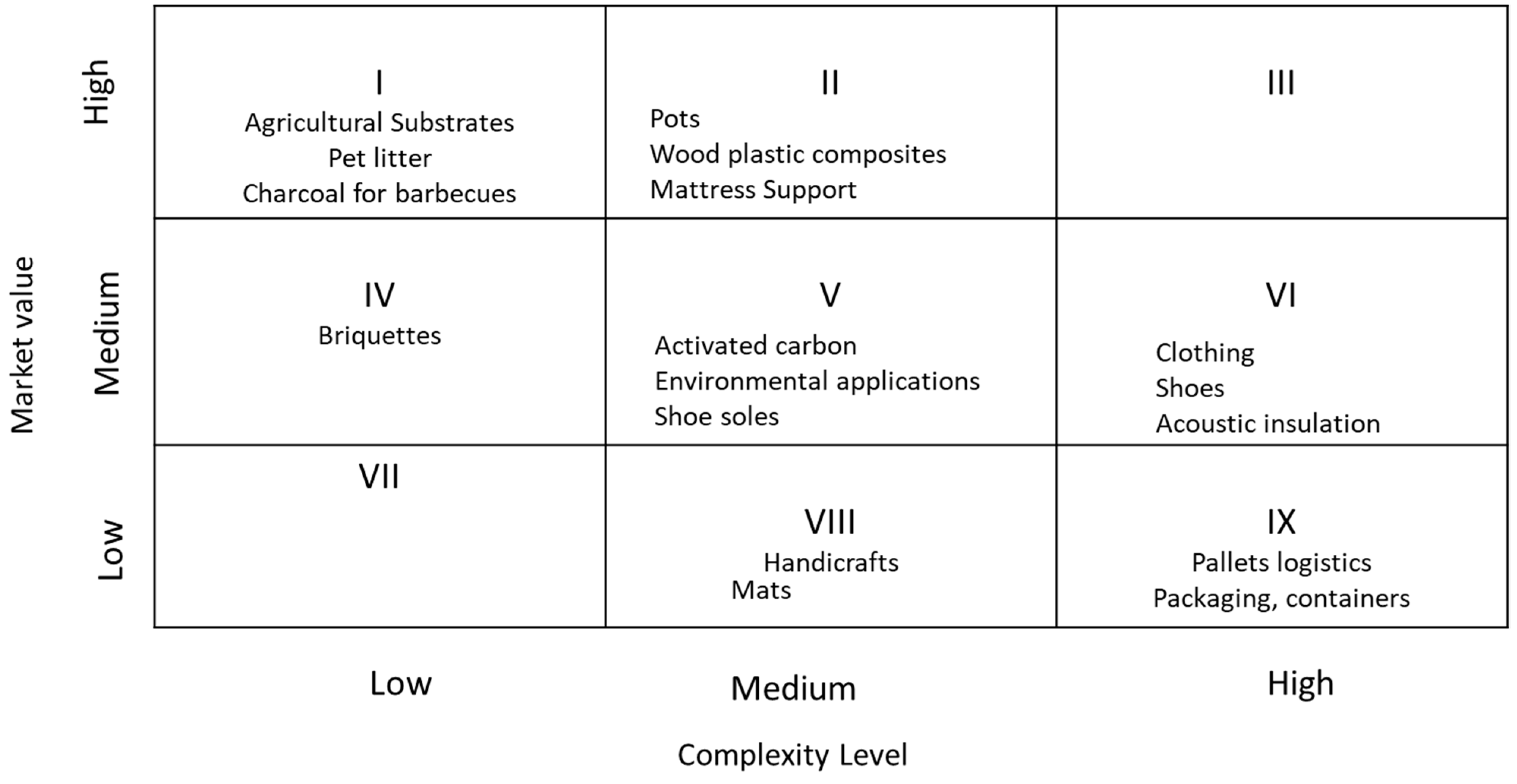

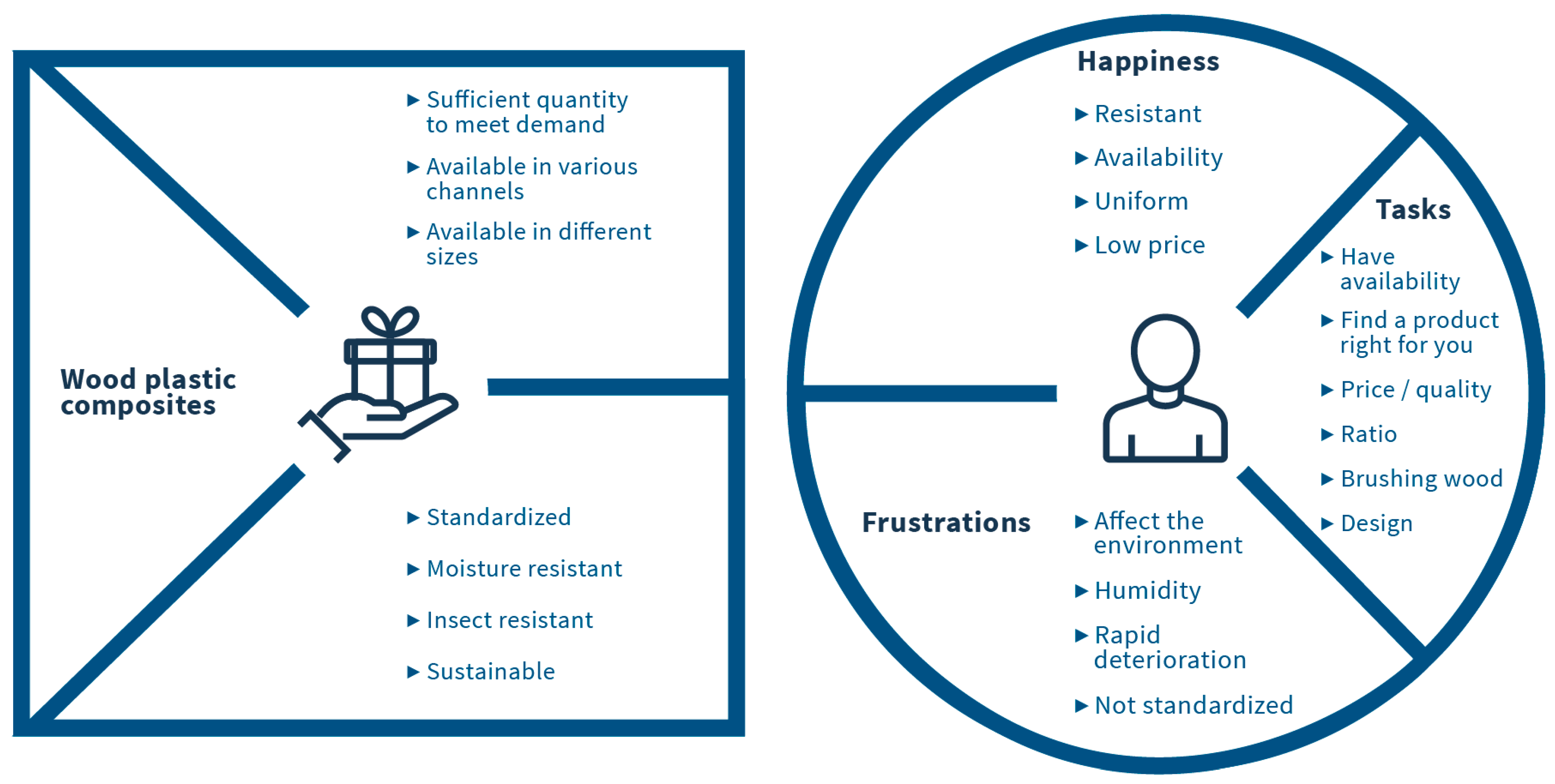
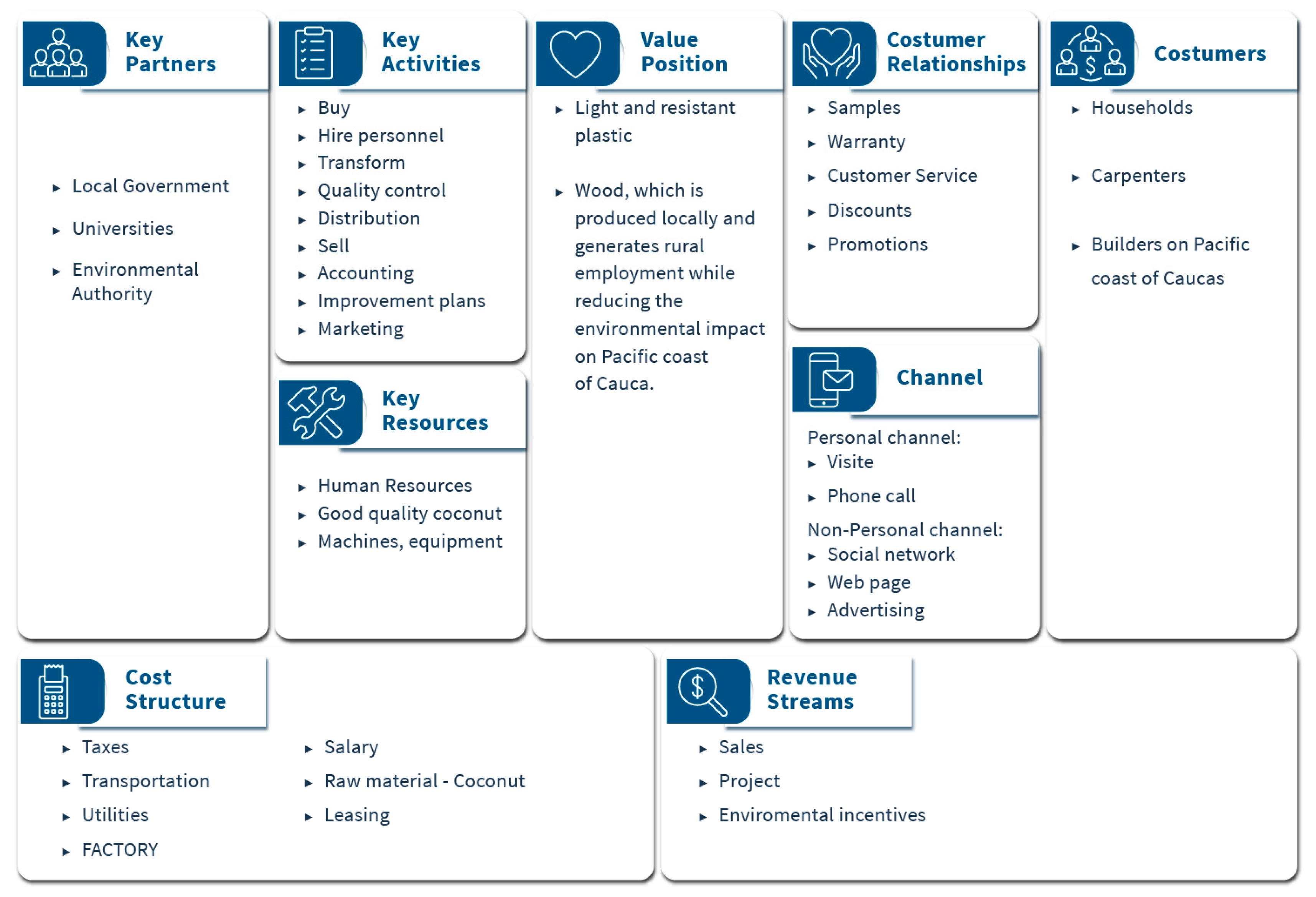
| Role | Formation | Functions |
|---|---|---|
| Design team from the community | 4 to 6 members of the community democratically elected with criteria of disciplinary diversity and gender equality. It is suggested that at least one young person from the community be involved in the team. | Participation in the defined workshops. Dialogue with the community. |
| Technical team | 4 to 6 members of the team that provides technical support, democratically elected with criteria of disciplinary and gender diversity. | Participation in the defined workshops. Support in research and search processes required in the application of the methodology. |
| Guidance team | 2 to 3 people, one of them with a high budget-decision power and broad scope of the project, a person with relevant knowledge of the technical aspects of product development, and/or a market contact person. Some of them can be part of the support team if necessary. | Decision-making. Participation in the defined workshops. Support in research and search processes required in the application of the methodology. |
| Facilitator | A person who knows the methodologies in which the hybrid methodology is supported. | Plans and executes each of the results-oriented moments. |
| Clients (optional) | 1 to 2 potential clients of the solutions to be implemented When commercial surveillance processes have been carried out previously, potential clients interested in the solutions to be developed can be found and are willing to participate in the co-creation processes collaboratively. | Participation in the defined workshops. |
| Stakeholders (optional) | 1 to 2 representatives of government or support entities who are interested in the processes and highly committed to the results of the project. | Participation in the defined workshops. |
| Moment | Estimated Time | Participants | Thought | Mode | Objective | |
|---|---|---|---|---|---|---|
| 1 | Understand the problem | 1.6 h | Technical team Community design team | Convergent | Understand | Collect elements of the actions from the phase of empathizing with the community and the analysis of the environment that allow the construction of a map of the problem via a shared method, through the consensus formulation of one or several guiding questions. |
| 2 | Ideation and clustering workshop | 1.6 h | Support team Community design team Clients Stakeholders | Divergent | Devise | Generate and cluster the greatest number of ideas possible that allow the solution of the questions and problems posed by the challenge that allows the identification of possible areas of opportunity. |
| 3 | Evaluation of ideas (3 × 3 matrix) | 1.5 h | Support team | Convergent | Define | Exclude areas of opportunity with low market value and high levels of complexity (not prioritizing yet). |
| Evaluation of ideas (PIN evaluation) | 1.5 h | Support team | Convergent | Define | Evaluate positive, negative, and interesting aspects of the solutions. |
| Moment | Estimated Time | Participants | Thought | Mode | Objective | |
|---|---|---|---|---|---|---|
| 4 | Analysis of feasibility | 1.5 h | Technical team | Divergent | Understand | Understand the feasibility issues of the ideas so far identified as potentially viable with some implementation drawbacks. |
| 5 | Box of ideas | 2 h | Selected participants from the technical team with technical knowledge in implementing prioritized ideas, Community design team | Divergent | Ideate | Generate the greatest possible number of ideas that allow solutions to the challenges to be resolved for the implementation of areas of opportunity identified so far. |
| 6 | Prototyping and SWOT | 2 h | Technical team, Community design team | Convergent | Prototype | Prioritize the most desirable and feasible areas of opportunity for the community by prototyping and evaluating strengths, weaknesses, opportunities, and threats. (Figure 3) |
| 7 | Matrix prioritization criteria | 1.5 h | Technical team | Convergent | Define | Evaluate the areas of opportunity according to agreed criteria in a prioritization matrix. Each selected criterion is assigned a weight in relation to its importance for its implementation and is scored from 1 to 5 where 1 is very unfavorable and 5 is very favorable. |
| Moment | Estimated Time | Participants | Thought | Mode | Objective | |
|---|---|---|---|---|---|---|
| 8 | Interviews with potential customers of the solutions | Not determined | Potential customers of the solutions prioritized so far | Convergent | Test | Telephone or face-to-face contact for commercial pre-validation with possible commercial allies for each of the pre-selected products, which allows the obtaining of information on the needs and characteristics of the demand. |
| 9 | Strategic framework | 2 h | Technical team, Community design team | Divergent | Understand | Identify attributes desirable by potential customers and analyze the competition and/or recognizable substitutes so far. |
| 10 | Value proposition | 2 h | Technical team, Community design team | Divergent | Ideate | Build the value proposition through the customer profile and value map for each solution prioritized so far. |
| 11 | TRIZ methodology and 2 × 2 matrix | 2 h | Technical team, Potential customers (optional) | Divergent-Convergent | Ideate- Define | Specify characteristics and aspects of the product that allows the research and development stage to create more value for customers. |
| 12 | Business model | 2 h | Technical team, Community design team | Convergent | Prototype | Differentiate the current business model from the future business model (to be implemented with the prioritized solutions), to establish concrete actions that the community must carry out as preparation prior to the transfer of technology from social, community, and organizational aspects. (Figure 4) |
| Findings | Guiding Question |
|---|---|
| The high cost of transportation will be a factor that will affect the low competitiveness for the transformation of products derived from coconut fiber. | How can transportation costs be reduced? |
| The limitations of stable access to public services in the territory will be a limitation in the coconut transformation processes. | How could they have access to public services for coconut transformation? |
| The community has had access to projects with infrastructure that have not been sustained. | How could the community obtain a transformation activity that is profitable and lasting? |
| Processing employment will compete with higher wages from illegal mining and illicit crops. | How could coconut processing could be a profitable and motivating work activity? |
| Coconut production and marketing is not attractive to young people. | How could young people be involved in coconut production and transformation processes? |
| The demand for sustainable products from coconut is increasing and production has not increased to demand levels. | How could coconut production be increased without generating deforestation processes and affecting the environment? |
| The producers are not interested in transformation because they have assured the commercialization of the fruit and the prices generate an acceptable profitability. | What products could be transformed on the Pacific coast of Cauca from the coconut that has assured commercialization in the market? |
| The presence of armed actors limits the investment of private companies and state investment in transformation activities. | It is not the responsibility of the project or its solution is beyond the scope. |
| The community has skills to develop operational and manual activities that are easy to use. | How could heavy-duty and/or manual labor skills of the community be integrated into coconut transformation processes on the Pacific coast of Cauca? |
| Marketers frequently grant financing to producers. | How could coconut producers be granted financing within an associative business model? |
| The current associative processes are not aimed at strengthening local entrepreneurship. | How could entrepreneurship for the transformation of coconut be strengthened? |
| The environmental impact of coconut production and transformation are not a priority for the community. | How could sustainable practices be generated in coconut production and transformation? |
| Producers do not implement good agricultural practices and phytosanitary handling in coconut processing. | How could better agricultural practices be implemented in phytosanitary handling in coconut production? |
| Area of Opportunity | Solution |
|---|---|
| Business strengthening | Strengthen associative processes Orient actions towards entrepreneurship Provide alliances and/or financing programs Have access to market information and marketing channels |
| Relations with the public sector | Involve the company, community, and public institutions in transformation processes (local, departmental, and national government) Choose better leaders and rulers Have greater visibility before the state Look for institutional accompaniment Consolidate initiatives of greater scope (chain), so that they can be sustained Access to supply of public services |
| Commercial strengthening | Platform for online sale of artisanal products produced in the area Add differentiation with own brands and/or certifications Involve other actors in the chain Emphasize the image of a clean, quality product with a social impact Establishment of commercial premises in main cities where the products are sold Include commercial allies in the project from the beginning |
| Accompaniment | Maintain training and assistance after the completion of the project Construction of a community outlook with a vision of economic and environmental sustainability Provide accompaniment for the management of pests and diseases |
| Technical | Simple transformation processes, easy to transfer, sustainable Where possible for use in the region (self-consumption) Simple machinery, easy-to-use mechanics Prioritize manual and mechanical transformation, since electricity and potable water are limited |
| Social | Include young children of coconut farmers Validation by the community before implementing the solutions |
| Product/Area of Opportunity | Implementation Problems | How Could It Be Undertaken? | Solution Ideas | Traffic Light |
|---|---|---|---|---|
| Agricultural substrates | Conditions required for the washing process High consumption of good quality water | Can river water be used to wash agricultural substrates or what conditions ought it to have? How is the washing process carried out for the production of agricultural substrates from coconut? | Pretreatment Material sedimentation Use rainwater—store it Aqueduct in the municipalities |  |
| Sand for pets | No implementation problems found (they are already producing it in the area) |  | ||
| Combustion briquettes | Generates a lot of smoke Determine binder Evaluate if it requires packaging Humidity storage conditions in the area Standardization Is a pelletizer required? | Is a binder required to produce coconut briquettes? How could the humidity be lowered to store the coconut briquettes? | Thermosetting or thermoplastic resins could be used depending on the use No binders needed Dehumidifiers can be used Packaging in hermetic bags |  |
| Plastic wood (wood substitute) | Plastic supplier | How could plastic be obtained in the area? | Recycled plastic available in the area |  |
| For all products | Considerable and stable power supply | How could a stable electricity supply be maintained for a transformation plant on the Pacific coast of Cauca? | With a diesel generating plant or gas plant |  |
| Non-woven felts for home and various applications (mattresses, rugs, etc.) Yarns, fabrics, and applications | Research production process Fiber length | How to obtain longer fibers? What is the production process for manufacturing felts, rugs, mattresses? | Machines that tear the fibers Method: a ragged machete |  |
| Plantholders, gardening applications | The process is simple, no implementation problems are identified |  | ||
| Packaging and containers | Stable economic supply Disposal of biodegradable packaging | How could a demand for higher-cost packaging be opened up? | Go to luxury packaging Highlight the environmental benefits of the solution |  |
| Activated carbon | High energy consumption | What processes exist for the production of coconut activated carbon? | Acids Oven temperatures |  |
| Criteria | % | 1 | 2 | 3 | 4 | 5 | 6 | 7 | 8 | 9 | 10 |
|---|---|---|---|---|---|---|---|---|---|---|---|
| Potential for short-circuit commercialization | 7% | 0.3 | 0.1 | 0.1 | 0.3 | 0.2 | 0.2 | 0.1 | 0.2 | 0.2 | 0.2 |
| Complexity for reaching a prototype | 18% | 0.8 | 0.9 | 0.63 | 0.78 | 0.78 | 0.66 | 0.78 | 0.66 | 0.54 | 0.54 |
| Possibility of self-consumption | 15% | 0.5 | 0.15 | 0.45 | 0.69 | 0.45 | 0.54 | 0.45 | 0.63 | 0.42 | 0.51 |
| Availability of other inputs in the territory | 12% | 0.5 | 0.48 | 0.54 | 0.51 | 0.39 | 0.44 | 0.42 | 0.51 | 0.42 | 0.39 |
| Impact of environmental factors on storage | 9% | 0.4 | 0.39 | 0.38 | 0.41 | 0.41 | 0.39 | 0.38 | 0.41 | 0.38 | 0.54 |
| Requirement of public services for production | 12% | 0.5 | 0.51 | 0.51 | 0.48 | 0.42 | 0.45 | 0.45 | 0.51 | 0.51 | 0.36 |
| Ease of provision of equipment and infrastructure for implementation | 13% | 0.6 | 0.56 | 0.56 | 0.61 | 0.61 | 0.56 | 0.56 | 0.35 | 0.65 | 0.26 |
| Demand in the domestic market | 14% | 0.6 | 0.45 | 0.42 | 0.62 | 0.5 | 0.53 | 0.42 | 0.49 | 0.59 | 0.5 |
| 100% | 3.93 | 3.44 | 3.50 | 4.09 | 3.56 | 3.58 | 3.47 | 3.55 | 3.51 | 3.10 | |
| 1. Agricultural substrate | 6. Mattresses | ||||||||||
| 2. Cat litter | 7. Handmade soap | ||||||||||
| 3. Combustion briquettes | 8. Threads for fabrics | ||||||||||
| 4. Wood plastic composites | 9. Packaging, Containers | ||||||||||
| 5. Pots | 10. Activated carbon | ||||||||||
| Product, Description, and Total Number of Votes | Prototype |
|---|---|
| Plastic wood for within the territory They emphasize that in its implementation they will use coconut fiber and recycled plastic existing in the area, thereby contributing to the environment. They envision a diversity of applications such as replacement of wood in the construction of houses, bridges, furniture, etc. They value the contribution as a substitute for wood, thereby helping to reduce deforestation. They represent a plant supplied from different points dedicated to the transformation of the material and its sale for self-consumption. Total number of votes: 44 | 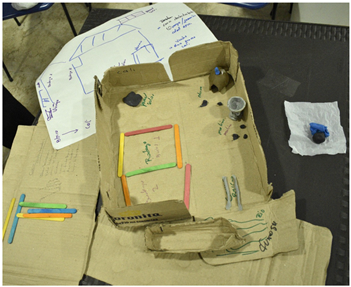 |
| Mattresses for self-consumption in the territory They represent a transformation plant, supplied with inputs locally. They emphasize that the fiber does not have chemicals and in addition to helping to mitigate the impact of the fiber, they consider it useful for self-consumption. For attendees it is easier to identify some machinery or part of the process, even to do it by hand. Total number of votes: 38 | 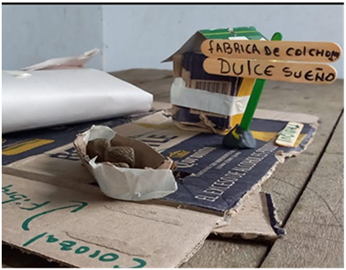 |
| Agricultural substrates They visualize a company located at an equidistant point in which the production process is carried out. They represent a place of reception of raw material, storage, transformation and delivery. They mention that its commercialization will be done towards the interior of the country since they know that it is a product that is frequently consumed in crops and nurseries, since it has properties that allow the seeds to develop easily. Total number of votes: 15 | 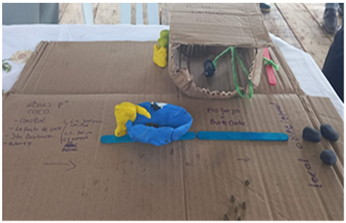 |
| Capacities | Capacity Description | Possible Ally |
|---|---|---|
| Things they already have | Human capacities with knowledge in personnel management, systems, marketing, administration, sales, accounting | There is capital formed in the community, and young people with training and seeking employment |
| Transport | There is an offer of transporters in the territory | |
| Things they do NOT yet have | Human capacities with knowledge of teamwork and associativity | Training with universities |
| Personnel with knowledge of coconut transformation processes and procedures | Training and transfer with universities | |
| Personnel with knowledge in food handling | Training and transfer with universities | |
| Public services with continuous service | Mayor’s Office, Governor’s Office | |
| A collection center | Hire | |
| Machinery and equipment for transformation | Projects with government sources and NGOs Can be purchased from multiple partners | |
| Endowment | Projects with government sources and NGOs Can be purchased from multiple partners |
Disclaimer/Publisher’s Note: The statements, opinions and data contained in all publications are solely those of the individual author(s) and contributor(s) and not of MDPI and/or the editor(s). MDPI and/or the editor(s) disclaim responsibility for any injury to people or property resulting from any ideas, methods, instructions or products referred to in the content. |
© 2023 by the authors. Licensee MDPI, Basel, Switzerland. This article is an open access article distributed under the terms and conditions of the Creative Commons Attribution (CC BY) license (https://creativecommons.org/licenses/by/4.0/).
Share and Cite
Delgado Eraso, D.A.; Grass Ramírez, J.F.; Muñoz, R.C. Methodology for Prioritizing Value-Added Options for Agricultural Products: Insights from Coconut-Producing Communities in Cauca, Colombia. Sustainability 2023, 15, 15290. https://doi.org/10.3390/su152115290
Delgado Eraso DA, Grass Ramírez JF, Muñoz RC. Methodology for Prioritizing Value-Added Options for Agricultural Products: Insights from Coconut-Producing Communities in Cauca, Colombia. Sustainability. 2023; 15(21):15290. https://doi.org/10.3390/su152115290
Chicago/Turabian StyleDelgado Eraso, Dayse Alexandra, José Fernando Grass Ramírez, and Ricardo Camacho Muñoz. 2023. "Methodology for Prioritizing Value-Added Options for Agricultural Products: Insights from Coconut-Producing Communities in Cauca, Colombia" Sustainability 15, no. 21: 15290. https://doi.org/10.3390/su152115290
APA StyleDelgado Eraso, D. A., Grass Ramírez, J. F., & Muñoz, R. C. (2023). Methodology for Prioritizing Value-Added Options for Agricultural Products: Insights from Coconut-Producing Communities in Cauca, Colombia. Sustainability, 15(21), 15290. https://doi.org/10.3390/su152115290







